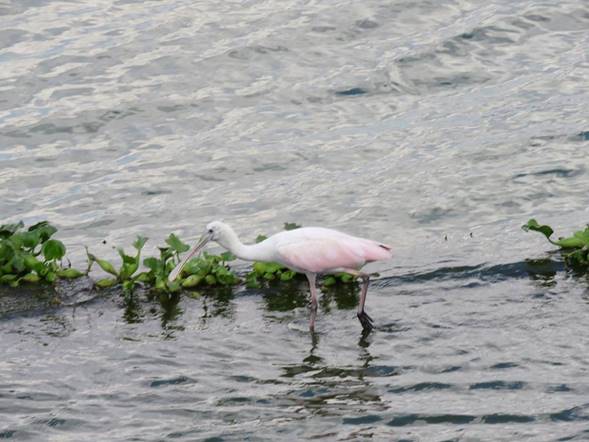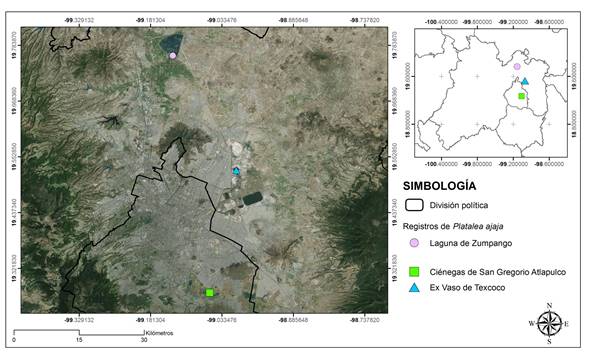Editor asociado: Fernando González García
The Roseate Spoonbill distributes in the Neotropics (tropical and subtropical zones) from southern United States, West Indies, and Mexico to Central and South America (Matheu and del Hoyo 1992, Howell and Webb 1995, Navarro and Peterson 2007). In Mexico, the species is resident along the Gulf of Mexico, as far as the Yucatan Peninsula. The range of the species also includes the Pacific Coastal Plain from Sonora to Chiapas; moreover, there are records from the Peninsula of Baja California, most of these records are located at seashore, and the observations at highlands are rare (Guerrero-Cárdenas et al. 2013). The Roseate Spoonbill inhabits swamps, wetlands, marshes and rivers, as well as mangroves and estuaries (Hancock et al. 1992, Matheu and del Hoyo 1992). Although the species is not considered to be threatened either nationally or internationally, it is nevertheless included in a list of priority species for conservation from the Mexican federal government (SEMARNAT 2014).
Lake Zumpango is the second most important reservoir for aquatic birds in the Valley of Mexico, since the larger stretch of wetlands at Lake Texcoco are being transformed by the undergoing construction of the new International Airport of Mexico City (NAICM by its Spanish acronym) (Alcántara and Escalante 2005). According to the project’s environmental impact assessment and possible mitigating and compensating measures for aquatic birds, other wetlands in the Valley of Mexico (including Zumpango) might receive the resident and migratory waterfowl displaced by the naicm (Córdova-Tapia et al. 2015, SCT 2016).Our objectives for this contribution are to provide the first record of P. ajaja at Lake Zumpango, along with comments on its distribution and range at the highlands of central Mexico.
We spotted the Roseate Spoonbill during a prospection of the waterfowl of Zumpango Lake, located northeast of the Valley of Mexico. On October 16, 2016 we covered the shore of this lake in a total of 15.8 km by car, making observations with the help of Bushnell fov 393ft 8 x 42 binoculars. As proof of these observations, photographs and videos were taken with a Canon S x 60 HS with 65x optical zoom. The time of sampling was from 14:00 to 18:00 h. Aiding in taxonomic identification of the waterfowl present, we used two field guides: Kaufman (2005) and Van Perlo (2006). In addition, we collected data of recorded P. ajaja from specialized literature and databases from aVerAves “ebird.org”.
We observed a juvenile specimen of P. ajaja feeding off the shore covered in water lilies on the west side of Zumpango Lake (19°45’45.60’’N, 99°8’6.76’’W; 2251 m a.s.l; datum WGS84; Figure 2) on the day of October 16, 2016. Such annotations were made around 16:00 h.

Figure 1 Roseate Spoonbill specimen observed in Zumpango Lake, State of Mexico, photographed on October 10, 2016 by Constanza Danaee Jiménez-Guevara.

Figure 2 Roseate Spoonbill location record in relation of the available records of the species in the Valley of Mexico.
The specimen observed presented characteristics of a juvenile which consists of immature plumage, color (whitish-pinkish), bill and a feathered head (Kaufman 2005, Van Perlo 2006) (Figure 1). There has been scarce records on this species at the Valley of Mexico, this new record is located at 29.69 km (in a straight line) to the nearest locality of northwest of the Ex-Texcoco Lake (Ramírez-Bastida et al. 2011) and 55 km (in a straight line) north to the swamp of San Gregorio Atlapulco (Meléndez-Herrada et al. 2013) (Figure 2). The specimen was feeding in the shore, which was covered by water lilies and trash also accompanied by a group of Snowy Egret (Egretta thula) and Great Egret (Ardea alba).
This is the first documented record for Lake Zumpango and the most recent record for the state of Mexico; Peterson and Navarro (2006) compiled species lists for the Valley of Mexico, from after 1950 and the nineteenth century, where Platalea ajaja’s presence is recorded on both dates; more recently Ramírez-Bastida et al. (2011) reported the presence of Roseate Spoonbill in the Ex-Texcoco Lake but not in Lake Zumpango. In the Valley of Mexico Meléndez-Herrada et al. (2013) report an occasional presence in the swamp of San Gregorio Atlapulco and the wetlands of Tláhuac in 1998; being these, the only records up-to-date in the database AverAves (Sullivan et al. 2009), therefore this record is the most recent for the Valley of Mexico.
The Roseate Spoonbill, has been previously recorded inner Mexico at El Conejo dam near Irapuato, Gto, the Ignacio Allende dam, San Miguel de Allende, Gto and the Constitution dams of 1917 and Centenario, in the vicinity of San Juan del Río, Qro. (Sullivan et al. 2009, Meléndez-Herrada et al. 2013). Howell and Webb (1995) consider P. ajaja an occasional visitor of Transmexican Volcanic Belt and Mexican Plateau, the recompiled data agrees with the status, due to the fact that the wetlands of Tláhuac observation was made in 1992 (Ayala-Pérez et al. 2013, Meléndez-Herrada et al. 2013), in the database aVerAves (Sullivan et al. 2009) the species is registered in 2008 in Guanajuato and in 2012 in Querétaro. Ramírez-Bastida et al. (2011) do not present a specific date of presence of the species in the Ex-Texcoco Lake. Since the wetlands in the Valley of Mexico were historically connected as one big lake, these records represent the high ability of dispersal that the species has, meaning that before the anthropogenic desiccation of this lake; the Roseate Spoonbill visited more frequently the inner wetlands of the Valley, probably in a migratory route, which nowadays could have stayed as a reminiscence of this migratory movement. Our observations of waterfowl in Lake Zumpango started in June 2016 with monthly visits to the lake, and ended in July 2017; the specimen was recorded on the first two weeks of October, and was not seen after that; neither was seen any other specimen, either juvenile or adult, around the area. With this new record for Lake Zumpango along with the previous records of the species for the Valley of Mexico, we infer that P. ajaja could be an occasional vagrant in all the wetlands of the area.
Lake Zumpango is a wetland highly altered by human activity, such as the presence of the highway Circuito Exterior Mexiquense, the construction of the tunnel Emisor Poniente and a tourist attraction on the east side of the lake with a questionable management. This wetland is surrounded by urban and agricultural areas; the water surface aspect is the result of dumping sewage water from such local areas north of the Valley of Mexico. Therefore, the condition of the habitat has been modified, and since it can be considered as an important reservoir for waterfowl, due to its size and the presence of a high variety of priority species for conservation (SEMARNAT 2014), where P. ajaja is considered, along with an important number of species of ducks and teals (Ramírez-Bastida et al. 2011).
We consider the bird to be vagrant, due to the distance from its expected breeding, wintering or migrating range, and taking in account that the specimen observed was a juvenile, its vagrancy may have been caused by inexperience at making its first migration. Therefore, we take in account that it is necessary to carry out a public monitoring program, which will allow analyzing the importance of this wetland as a habitat for species like P. ajaja that may require a transitory wetland.











 text new page (beta)
text new page (beta)


